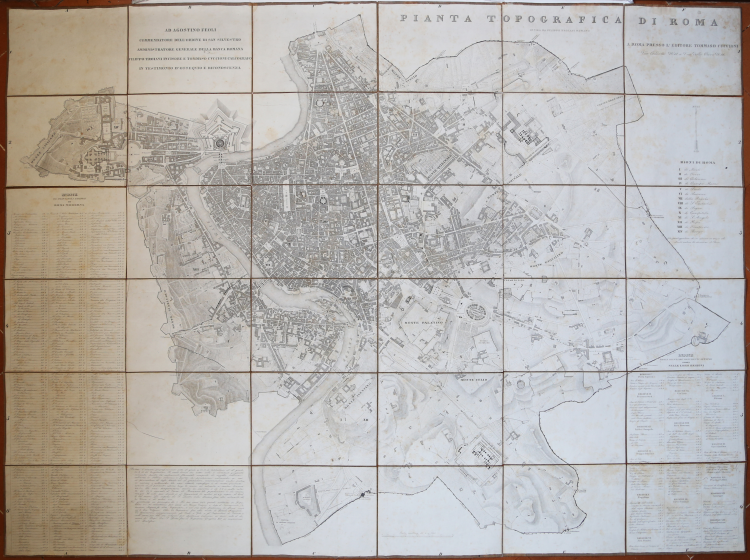



| Reference: | S41680 |
| Author | Tommaso CUCCIONI |
| Year: | 1840 |
| Zone: | Rome |
| Printed: | Rome |
| Measures: | 1245 x 930 mm |


| Reference: | S41680 |
| Author | Tommaso CUCCIONI |
| Year: | 1840 |
| Zone: | Rome |
| Printed: | Rome |
| Measures: | 1245 x 930 mm |
Rare vertical projection map, oriented with north at the top.
Engraved by Filippo Troiani for the publisher Tommaso Cuccioni.
On the left heading: Indice de' principali edifizi di Roma moderna. On the right: Indice degli avanzi de' monumenti antichi posti nelle loro Regioni.
Printed in four sheets. At the bottom news that mentions the name of Pope Gregory XVI (1830-1846), hence the dating to about 1840. In its accurate representation of the city Troiani certainly held to reference the map by Census edited a decade earlier but still current. At the top left dedication to Agostino Feoli, general administrator of the Banca Romana (see Marigliani, 2007, pp. 346-347).
Etching, printed on four large sheets, cut, applied on original canvas and folded several times to a case, small oxidation, otherwise in good condition.
Literature
Scaccia Scarafoni (1939): n. 289; Frutaz (1962): n. 196; Marigliani (2007): pp. 346-347, n. 279.
Tommaso CUCCIONI (Roma, 1790 circa – 23 agosto 1864)
|
He is one of the first and most renowned Roman photographers of the nineteenth century whose date of death (1864), but not his date of birth. His initial activity, however, was that of engraver and chalcographer, devoting himself to the trade of prints, with a store first in Via della Croce, n. 88, and then in Via Condotti, n. 18, as can be seen from the repertoires of the time of Gregory XVI who indicate him as a dealer of prints, paintings and fine art objects. In the Forties, together with the sale of chalcographic prints, he also began the sale of daguerreotypes and calotypes that he did not yet execute personally, but he commissioned to other Roman professionals of the origins and especially to G. Caneva, his great friend. Only after 1851, that is after the finalization of the wet collodion process, Cuccioni began his new and very lucky career as a photographer because only then, and not before, photography really set itself as an alternative means - with respect to the other reproductive techniques of the past - in the field of image production and reproduction.
Translated with www.DeepL.com/Translator (free version)
|
Tommaso CUCCIONI (Roma, 1790 circa – 23 agosto 1864)
|
He is one of the first and most renowned Roman photographers of the nineteenth century whose date of death (1864), but not his date of birth. His initial activity, however, was that of engraver and chalcographer, devoting himself to the trade of prints, with a store first in Via della Croce, n. 88, and then in Via Condotti, n. 18, as can be seen from the repertoires of the time of Gregory XVI who indicate him as a dealer of prints, paintings and fine art objects. In the Forties, together with the sale of chalcographic prints, he also began the sale of daguerreotypes and calotypes that he did not yet execute personally, but he commissioned to other Roman professionals of the origins and especially to G. Caneva, his great friend. Only after 1851, that is after the finalization of the wet collodion process, Cuccioni began his new and very lucky career as a photographer because only then, and not before, photography really set itself as an alternative means - with respect to the other reproductive techniques of the past - in the field of image production and reproduction.
Translated with www.DeepL.com/Translator (free version)
|